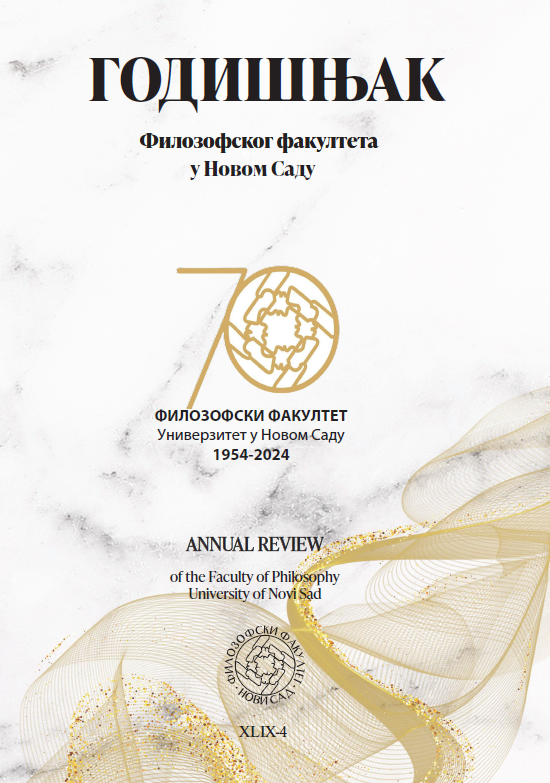A HUMAN THING IS TO LAUGH. A POSSIBLE INTERPRETATION OF THE THEME OF LAUGHTER IN NOVELLAS FROM BOCCACCIO TO GRAZZINI
Main Article Content
Abstract
In this article we aim to analyze the laughing character in late medieval and renaissance
novellas, which is understood as a narrative strategy of the author, i.e. his voluntary and
conscious action intended to offer an interpr etative expedient for the correct understanding
of the narrative. Starting from the first novella in Decameron, considered programmatic in
various aspects, other novellas from the Decameron will be included in the diachronic
analysis, as well as those writ ten by Sacchetti, Salernitano and Grazzini. Since its birth and
subsequent codification, the novella had a double value: its connection with the oral
tradition implied direct contact with the public, themes of the moment or current social
interest, wit and promptness of speech; on the other hand, the literary diegesis elaborated
within the rules of the artes dicendi et narrandi was enriched by the individual preparation
and singular style of the author. The literary novella is therefore the mirror of this
c ommunicative act par excellence , because it represents its totality and completeness; the
extradiegetic and metadiegetic excursus provided not only descriptions of the place, time,
occasion and participants of the narrative event, but also the consideratio ns on the value
and meaning of the work offered by the author himself or of the author as the second
narrator. Consequently, the narrator's reaction to the story or the character's reaction to the
narrated event that is at the origin of the story should be in line with the communicative
message transmitted in it; the laughing narrator/character becomes the projection of the
ideal narrative audience. The first theoretical treatises on the novella define it as a genre
that imitates an ugly action according to the principles of ridiculousness in order to
entertain. The comical effect is achieved by imitating the actions ( res ) or transmitting the
words of others. Laughing at obscenity, religious hypocrisy or a joke is an indication of a
critical society, capable of considering, measuring and accepting its own vices in order to
be able to reproach them. Following the same logic, the absence of these themes together
with the consequent ostracism of laughter from the literary space, denotes both censorship
and socia l and moral crisis.
Downloads
Article Details

This work is licensed under a Creative Commons Attribution-ShareAlike 4.0 International License.
References
Aristotele (1974). Dell'arte poetica, a cura di Carlo Gavallotti, Milano: Mondadori.
Bahtin, M. (1978). Stvaralaštvo Fransoa Rablea i narodna kultura srednjega veka i renesanse, Beograd: Nolit.
Bandello, M. (1943), Novelle, Milano: Mondadori editore.
Bargagli, G. (2009). Dialogo de’ giuochi che nelle vegghie sanesi si usano fare, in N. Ordine, Teoria della novella e teoria del riso nel Cinquecento, pg. 165-182, Napoli: Liguori.
Bergson, A. (2004), O smehu, Novi Sad: Vega media.
Boccaccio, G. (2009), Decameron, a cura di Vittore Branca, Milano: Oscar Mondadori.
Bonciani, F. (2009), Lezione sopra il comporre delle novelle in N. Ordine, Teoria della novella e teoria del riso nel Cinquecento, pg. 127-164, Napoli: Liguori.
Borsellino, N. (1989). La tradizione del comico. L’eros, l’osceno, la beffa nella letteratura italiana da Dante a Belli. Garzanti: Milano.
Bragantini, R., Il riso sotto il velame, Firenze: Leo S. Olschki Editore, 1987.
Ferrante, J. M. (1978). Narrative Patterns in the “Decameron.” Romance Philology, 31(4), 585–604. http://www.jstor.org/stable/44941943.
Grazzini, A. (1868). Le Cene, Napoli: Società editrice dei novellieri italiani, versione elettonica.
Meletinski, J. (1997). Istorijska poetika novele, Novi Sad, Matica srpska.
Milinković, S. (2008). Preobražaji novele. Novela od V. Vrčevića do S. Matavulja i italijanska novelistička tradicija, Beograd: Društvo za srpski jezik i književnost Srbije.
Nardi, F. (2010). Comico e modernità nel »Discorso del riso« di Basilio Paravicino. Lecce: Pensa Multimedia.
Ordine, N. (2009). Teoria della novella e teoria del riso nel Cinquecento, Napoli: Liguori.
Picone, M. (1989). L’invenzione della novella italiana. Tradizione e innovazione. La novella italiana, vol. I, Atti del Convegno di Caprarola, 19-24 settembre 1988, pp.119-154, Roma: Salerno editrice.
Rossi, L. (1989). Ironia e parodia nel Decameron: Da Ciappelletto a Griselda. La novella italiana, vol. I, Atti del Convegno di Caprarola, 19-24 settembre 1988, pg. 365-405, Roma: Salerno editrice
Sacchetti, F. (1970), Il Trecentonovelle, in: E. Faccioli (a cura di), Torino: Einaudi, disponibile su https://archive.org/details/trecentonovelleilfrancosacchetti/mode/2up
Salernitano, M. (1874). Il Novellino, restituito alla sua antica lezione da Luigi Settembrini, Napoli: Antonio Morano Librajo-Editore.
Straparola, G.F. (1927).
Le piacevoli notti , in: Giuseppe Rua (a cura di), Bari:
Gius. Laterza & Figli Tipografi EditoriLibrai, disponibile su
https://www.liberliber.it/online/autori/autori s/giovanni francesco
straparola/le piacevoli notti/
Segre, C. (1974).
Le strutture e il tempo , Torino:
Trissino, G.G. (1970), La quinta e la la sesta divisione della Poetica in Weinberg, B., Trattati di poetica e retorica, volumi II, Gius. Bari: Laterza &figli.
Ženet, Ž. (2002). Figure V , Novi Sad: , Svetovi.




